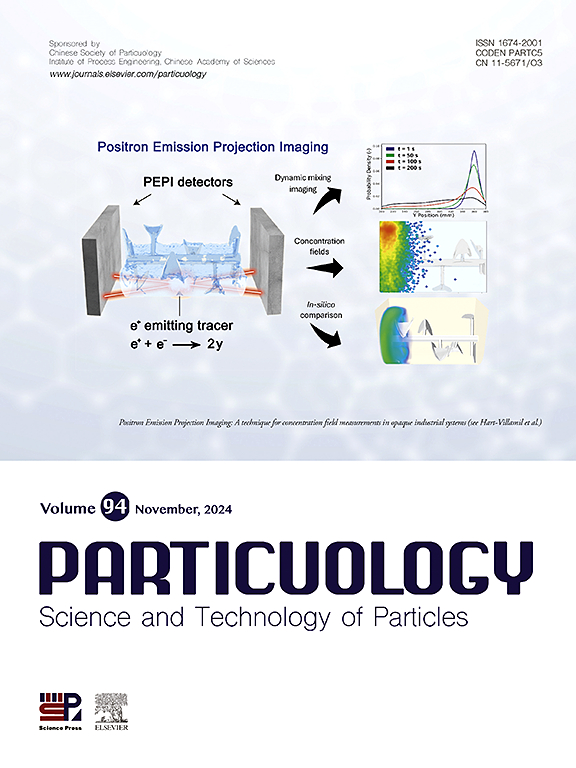间歇式球磨机中不同粒度陶瓷球对石英研磨动力学的影响
IF 4.1
2区 材料科学
Q2 ENGINEERING, CHEMICAL
引用次数: 0
摘要
研究了陶瓷球直径对湿式球磨机中不同粒度石英晶体研磨性能的影响,建立了石英研磨过程中的种群平衡模型。结果表明,一级破碎动力学模型能较准确地描述石英的破碎行为。石英矿物的破碎率随陶瓷球粒度的减小而减小,但小粒度陶瓷球的破碎率受石英给料粒度的影响较小。另一方面,石英磨矿产品在短时间内具有明显的零级细粒输出特征,并且随着陶瓷球直径的减小,矿物的最大磨矿能力先增大后减小。利用最终的石英破碎参数,可以准确地计算出石英破碎结果的粒度分布。用种群平衡模型模拟的粒度分布数据与石英磨矿过程的实验数据吻合较好。本文章由计算机程序翻译,如有差异,请以英文原文为准。

Effect of different size ceramic balls on quartz grinding dynamics in batch ball mill
This study investigated the effect of ceramic ball diameter on grinding performance of quartz crystal with different particle sizes in wet ball mill, and established a population-equilibrium model in quartz grinding process. The results show that the first-order crushing kinetic model can accurately describe the grinding behavior of quartz. The crushing rate of quartz mineral decreases with the decrease of the size of ceramic ball, but the crushing rate of small-size ceramic ball is less affected by the quartz feed size. On the other hand, quartz grinding products have obvious zero-order fine grain output characteristics in a short time, and with the decrease of ceramic ball diameter, the maximum grinding capacity of minerals increases first and then decreases. The grain size distribution of quartz grinding results can be calculated accurately by using the final quartz crushing parameters. The particle size distribution data simulated by the population balance model is in good agreement with the experimental data of quartz grinding process.
求助全文
通过发布文献求助,成功后即可免费获取论文全文。
去求助
来源期刊

Particuology
工程技术-材料科学:综合
CiteScore
6.70
自引率
2.90%
发文量
1730
审稿时长
32 days
期刊介绍:
The word ‘particuology’ was coined to parallel the discipline for the science and technology of particles.
Particuology is an interdisciplinary journal that publishes frontier research articles and critical reviews on the discovery, formulation and engineering of particulate materials, processes and systems. It especially welcomes contributions utilising advanced theoretical, modelling and measurement methods to enable the discovery and creation of new particulate materials, and the manufacturing of functional particulate-based products, such as sensors.
Papers are handled by Thematic Editors who oversee contributions from specific subject fields. These fields are classified into: Particle Synthesis and Modification; Particle Characterization and Measurement; Granular Systems and Bulk Solids Technology; Fluidization and Particle-Fluid Systems; Aerosols; and Applications of Particle Technology.
Key topics concerning the creation and processing of particulates include:
-Modelling and simulation of particle formation, collective behaviour of particles and systems for particle production over a broad spectrum of length scales
-Mining of experimental data for particle synthesis and surface properties to facilitate the creation of new materials and processes
-Particle design and preparation including controlled response and sensing functionalities in formation, delivery systems and biological systems, etc.
-Experimental and computational methods for visualization and analysis of particulate system.
These topics are broadly relevant to the production of materials, pharmaceuticals and food, and to the conversion of energy resources to fuels and protection of the environment.
 求助内容:
求助内容: 应助结果提醒方式:
应助结果提醒方式:


